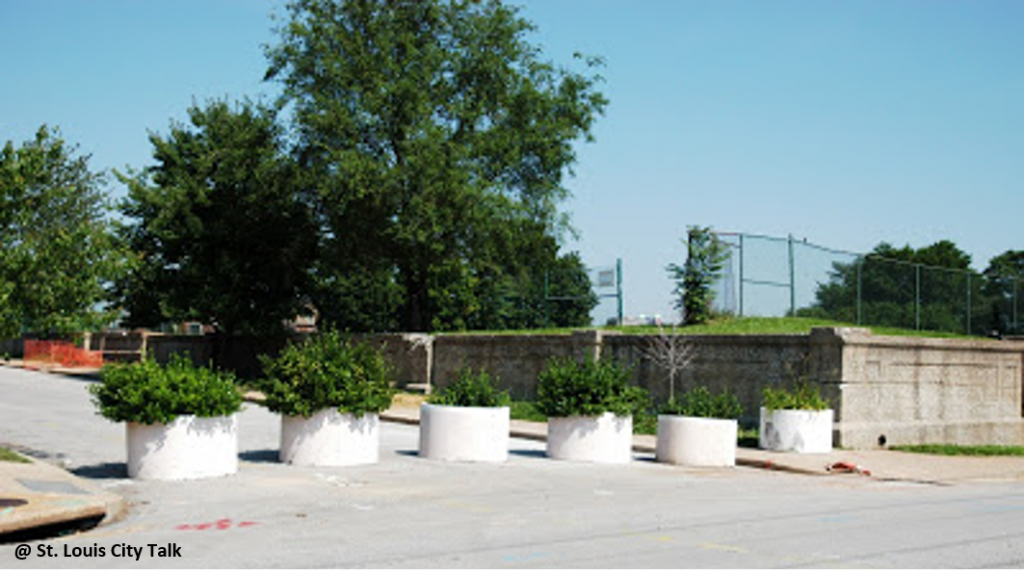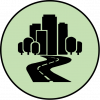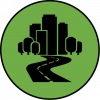
1. Presentation
This is a traffic calming measure, usually associated with other measures of this kind (for example, Limited speed areas, Horizontal and vertical road deflections, Road narrowing). This measure intends to reduce car connectivity to levels lower than the remaining transport modes. It usually originates from the need to accommodate the interests of different transport modes in a limited public space, resulting in the restriction of certain trip choices for the car in order to allow non-motorized transports to have more space, safety and greater access than the car. This leads to greater trips or less direct routes (with unintuitive turns) for the car..
2. Objectives
- Redistributing public space to give greater priority to non-motorized transports.
- Creating safe zones for pedestrians and cyclists and discouraging car use in urban centres.
3. Measure’s importance
Restricting car use, when allied to the facilitation of walking and cycling, provides comfort and safety to cycling and creates an efficient and attractive environment to the remaining transportation means. These measures contribute to making the streets more pleasant and less dominated by motorized vehicles.
1. Good Practices
– Must be associated with measures that promote transportation alternatives (See Bike sharing systems, Integration of bicycle in public transport, Connect people and public transport).
– Must be associates with other car restriction measures (See Limited car access areas, Car free Zones, Car parking restrictions, Limited speed areas, Road user charging, Parking pricing for vehicles).
– Design the intervention considering streets are used for multiple purposes, namely traveling, walking, socializing, selling and living, in the sense of them being the entrances to people’s homes.
– Establish base principles for this kind of interventions, considering the social values and costs of each transportation means and the different activities that go on in the streets.
– Insert this measure in a wide-ranging and comprehensive traffic management strategy.
– New interventions should receive extra traffic signs to alert the new conditions. After a few years, the extra signals can be removed.
– Monitor citizens’ adaptation to changes and reformulate measures to respond to users’ needs, without compromising sustainable ideals (See Management, monitoring and maintenance).
– Explain the principles behind the measures taken so that their need and functioning are clear (See Information).
2. Actions
 | Partial closing of a street (closing one traffic lane) Eliminating a traffic lane, forcing cars into taking a longer, alternative route. |
 | Dead end streets Placing physical barriers over the total width of the car lane, closing traffic to motorized vehicles and artificially creating a dead end street (cul-de-sac), but allowing cyclists and pedestrians to pass. Learn more: chris-prener.github.io/barriers/background/ |
 | Imposing car traffic deviations Restricting continuous movements in intersections to motorized vehicles, forcing the drivers to complete longer trajectories. This restriction may be achieved by diagonally placing obstacles in the traffic lane, or by implementing traffic signs. Either way, walking and cycling should still be allowed. Learn more: www.localecology.org/localecologist/2006/12/livable-traffic-calmed-streets_13.html |

In Saint Louis, Missouri (E.U.A.), an artificial dead end street was created using concrete planters to close the street.
1. Impacts
 | Mobility system efficiency Reduces conflicts between the different transportation means, increasing their efficiency. In addition, by promoting transports alternative to the car, traffic congestion is reduced. However, if the alterations aren’t properly planned or managed, the areas to where the traffic is deviated to may suffer negative consequences. |
 | Livable streets The absence of automobiles creates more pleasant streets. The impacts increase according to the dimension of the intervention and whether or not is complemented by other traffic calming strategies. |
 | Protection of the environment Noise and gas pollution reduces in the areas with no cars. However, if the measure isn’t associated with other car restrictions and strategies to promote alternative transportations means, the areas accessible by car will suffer greater pollution levels. |
 | Inclusion, equity and accessibility Improves conditions for low-cost transport modes, creating fairer conditions, especially if there is a special exemption for the vehicles of disabled people. |
 | Safety and comfort Reducing car traffic increases safety for pedestrians and cyclists. In addition, by promoting more livable streets, there’s more surveillance of the public space. |
 | Economic value Several studies show reducing car traffic and improving conditions for pedestrians and cyclists significantly increases sales in street commerce and property’s value. |
 | Awareness and acceptability Creating barriers for cars and removing them for pedestrians, cyclists and public transportation changes daily habits. |
Legend:
| Very positive | Positive | Neutral | Negative | Very negative |
2. Barriers
 | Legal No barriers. |
 | Finance Reconfiguring infrastructure can have greater costs. |
 | Governance Involves public authorities and planning technicians. |
 | Political acceptability There might be some resistance to creating barriers to car circulation. However, those barriers might be past with comprehensive informative campaigns. |
 | Public acceptability There might be some resistance to creating barriers to car circulation. However, those barriers might be past with comprehensive informative campaigns. |
 | Technical feasibility Depends on the conditions of the urban fabric. |
Legend:
| No barrier | Minimum barrier | Moderate barrier | Significant barrier |
3. Budget
It is necessary to account for the costs of acquiring services to elaborate an urban mobility plan for the area in question and the purchase of the corresponding traffic signs. In case the introduction of new infrastructure is deemed necessary, the prices will vary according to the materials and/or the objects to introduce.
For example, widening sidewalks has advantages in urban space quality, yet it demands more infrastructure and a team with specific technical knowledge. On the contrary, introducing obstacles in the street can be achieved with low-cost materials. In this case, associating the community to the design and implementation process may create stronger bonds between the residents and the space, strengthening their acceptability of the intervention.
| Area | Measure | Unit | Cost | Implementation year |
| Lisbon, Lisbon’s Metropolitan Area (Portugal) | Surface rearranging | Eliminating a traffic lane; widening the sidewalk; creating a cycle path; creating car parking | 556 595,71 € | 2014 |
Case Study 1: Barcelona’s Superblocks – Change the Grid, Change your Neighborhood
In 2016, Barcelona’s municipality decided that it would transform part of its car grid into “superblocks” as a way to prioritize people over cars. In these “superblocks”, access by motorized vehicles is allowed, but crossing traffic is not. The streets are designed to make drivers feel like visitors, with reduced car priority in routes indicated for motorized vehicles inside the “superblock” perimeter. The success of this measure, which does not require major alterations to the urban planning, has stimulated other Spanish cities to implement it.
Learn more: http://www.bcnecologia.net/en/conceptual-model/superblocks
Impacts:
 | Mobility system efficiency There has been a big car traffic reduction in the “superblocks” and an improvement in the non-motorized transportation modes. |
 | Livable streets “Superblocks” increase availability and quality of public space, encouraging more people to enjoy the street, including children and elderly people. |
 | Protection of the environment “Superblocks” have reduced the environmental impact of motorized vehicles. |
 | Inclusion, equity and accessibility The streets are more accessible to everyone, including children and elderly people. In addition, each grid section has universal design. |
 | Safety and comfort “Superblocks” encourage residents to use the street more safely and with more comfort. Inside, the streets have a 10km/h speed limit. |
 | Economic value “Superblocks” stimulate the local economy. |
 | Awareness and acceptability Living in a quality public space is the best instrument to sensitize and reduce resistance to diffusing non-motorized transports. |
Legend:
| Very positive | Positive | Neutral | Negative | Very negative |
Cairns, S., Hass-Klau, C. and Goodwin, P. (1998). Traffic of highway capacity reductions: assessment of the evidence. London: Landor Publishing.
Federal Highway Administration University Course on Bicycle and Pedestrian Transportation (2006). Lesson 20: Traffic calming. Accessed 8 July 2019. Available at: https://www.fhwa.dot.gov/publications/research/safety/pedbike/05085/chapt20.cfm
NACTO (2014). Urban Bikeway Design Guide: Volume Management. Accessed 8 July 2019. Available at: https://nacto.org/publication/urban-bikeway-design-guide/bicycle-boulevards/volume-management/
KonSULT. Knowledgebase on Sustainable Urban Land use and Transport. (2014). Physical Restrictions. Accessed 18 June 2019. Available at: http://www.konsult.leeds.ac.uk/pg/12/#a
VTPI. Victoria Transport Policy Institute (VTPI) (2018). Road Space Reallocation. Online Transportation Demand Management (TDM) Encyclopedia. Accessed 18 June 2019. Available at: https://www.vtpi.org/tdm/tdm56.htm
VTPI. Victoria Transport Policy Institute (VTPI) (2018). Vehicle Restrictions. Online Transportation Demand Management (TDM) Encyclopedia. Accessed 18 June 2019. Available at: http://www.vtpi.org/tdm/tdm33.htm
